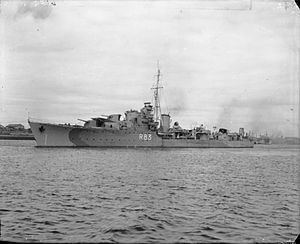Commissioned 30 June 1943 Launched 9 November 1942 | Laid down 12 November 1941 Decommissioned 1977 Construction started 12 November 1941 Length 111 m | |
 | ||
Fate Withdrawn from service 1977; Broken up 1980 | ||
HMS Ulster was a U-class destroyer of the British Royal Navy that saw service during World War II. She was later converted into a Type 15 fast anti-submarine frigate, with the new pennant number F83. Ulster would be the third vessel in Royal Navy history to have that name.
Contents
With funds gathered through a Naval Savings Campaign in 1942 known as Warship Week, the ship was adopted by the civil community of Ulster's County Down.
Specifications
HMS Ulster had a displacement of 2091 tons when full and dimensions of 363 feet (111 m) long, 36 feet (11 m) wide and a draught of 10 feet (3.0 m). She was powered by 2 Admiralty 3 drum type water boilers, which gave 40,000 horsepower (30 MW) through twin shafts making a top speed of 37 knots (69 km/h; 43 mph). Her range was 4,860 nautical miles (9,000 km; 5,590 mi). The crew complement was 180 hands.
Armaments on the original construction and fitting consisted of: four 4.7 inch Mark IX guns, two 40mm Bofors, six QF 20mm Oerlikons and two quad-mounted 21 inch Mark IX torpedo tubes, as well as radar, sonar and depth charges.
Second World War service
In June 1943 construction was completed and Ulster went into duty in the English Channel. By the end of the year she would be on duty in the Mediterranean and Adriatic on anti-submarine missions, receiving damage from return fire. In April 1944 the destroyer would return to home waters and towards the end of the year would refit and have new radar and advanced warning systems installed.
At the beginning of 1945 Ulster was transferred to the British Pacific Fleet with the pendant "D", in keeping with the American system.
Pacific
Ulster, while serving with the British Pacific Fleet, had a near miss by a Japanese kamikaze and a 500 lb bomb during Operation Iceberg, the invasion of Okinawa. Ulster had her machinery spaces blown in and had to be towed to Leyte for temporary repairs, whence it sailed for Australia. Two sailors died and one was seriously injured in the attack. Nearly six months after the attack in October 1945 Ulster made it back to HM Dockyard, Chatham in England to undergo full repairs.
Post-War
After the Second World War Ulster was mostly used as a training vessel and for reserve purposes. Between 1953 and 1955 she underwent a full conversion to a Type 15 frigate at Chatham Dockyard. She then joined the 8th Frigate Squadron soon after. Soon she was on duty in Iceland, Azores, West Indies, Caribbean, and tours to the United States. In 1958 Ulster helped to restore power ashore in Nassau, Bahamas.
In 1964 she was again put into reserve in Plymouth. A year later in 1965, Ulster was re-commissioned in the 2nd Frigate Squadron, but then in 1967 was withdrawn from operational service.
During the late 1960s, Ulster was used by naval ratings from HMS Vernon for seagoing training in the Sonar Control Room (SCR). In 1970 she was present at Portsmouth Navy Days; at the time she was the Navy's Navigational Training Ship. The destroyer was used as a training hulk at HMS Raleigh between 1977 and 1980. Finally in 1980 Ulster was bought by Thos W Ward and broken up.
